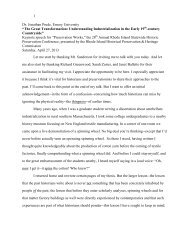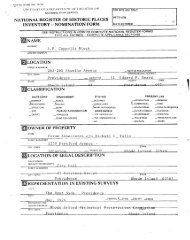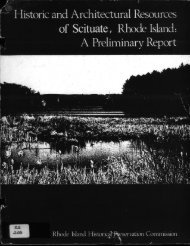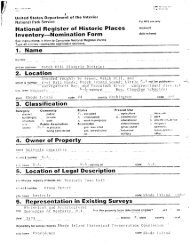National Park Service - Rhode Island Historical Preservation ...
National Park Service - Rhode Island Historical Preservation ...
National Park Service - Rhode Island Historical Preservation ...
Create successful ePaper yourself
Turn your PDF publications into a flip-book with our unique Google optimized e-Paper software.
-<br />
0MB P- 1024-0018<br />
NPS Form io900i En,- 10-31-U<br />
3-82 - - -<br />
United States Department of the Interior<br />
<strong>National</strong> <strong>Park</strong> <strong>Service</strong><br />
<strong>National</strong> Register of Historic Places<br />
Inventory-Nomination Form -<br />
Continuation sheet SO Item number 8<br />
Page 6<br />
century--an-intact, active industrial village of great historical<br />
interest, picturesque and appealing.<br />
In addressing this village and its architectural<br />
significance, several points stand out. First, it harbors a<br />
major complex of mid- and late nineteenth-century industrial<br />
buildings #37 which both reflect the evolution of textile mill<br />
design over six decades in terms of size, massing, roof form, and<br />
fenestration, and also is the product of a continuance of local<br />
vernacular masonry construction traditions for which Washington<br />
- County is known and which was fostered in Peace Dale by the<br />
generally conservative, Quakerly tastes of Rowland Hazard II who<br />
designed many of these buildings and who clearly wished to create<br />
a unified ensemble. Secondly, the civic architecture of Peace<br />
Dale, closely related to that of the mills, is very consistent in<br />
material, design and. quality. One civic building is outstanding,<br />
Frank Angell’s Richardsonian Romanesque Hazard Memorial of 1891-<br />
- 92 #30. Thirdly, vernacular architecture in Peace Dale<br />
possesses a remarkable consistency of scale, design, and<br />
ambition. This -is seen especially in Peace Dale domestic - -<br />
architecture, most interestingly in its many L-plan, gable-and- -<br />
cross-gable cottages. But in a teal sense, this strong<br />
journeyman’s vernacular quality can be found in all building here<br />
and this leads to a fourth poiht: Peace Dale architecture is the<br />
product, largely, of-one man’s design efforts and patronage.<br />
Rowland Hazard II’s architectural vocabulary; taste, and social<br />
aims created a unified body of work possessing enormous interest.<br />
He was not a gifted architect; his aesthetic was limited. But<br />
herein lies the strength of his achievement. He. gave a good,<br />
workthanlike air to the village, enlivened by an occasional<br />
eccentricity like the watering trough #36 or company office<br />
#37A. It was Hazard, from an architectural viewpoint, who made<br />
this village distinctive and fine, in the same way that a wellcrafted<br />
piece of country furniture can, be fine.<br />
--<br />
- Art may be deemed an area of significance relevant to Peace<br />
Dale, for here stands, at the village center on the grounds of<br />
Hazard Memorial library, Daniel Chester French’s beautiful 1920<br />
monument, ,"The Weaver" #30, commissioned by Hiss Caroline<br />
Hazard to honor her father and brothers, and, in effect, to<br />
ceremoniously<br />
control over<br />
bid farewell<br />
the village’s<br />
through<br />
destiny.<br />
art to the era of Hazard<br />
-<br />
- Peace Dale bears notice, in a contrary fashion, as an<br />
example of community planning. It is a -planned industrial<br />
village in which every effort was made to make it look unplanned,















